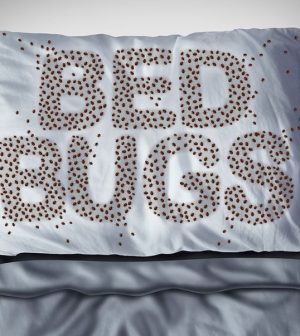- Skip Storing This Everyday Product in the Fridge Door
- Green Tea + B3 Pairing May Boost Brain Health
- Navigating Your Midlife Crisis: Embracing New Possibilities
- City Raccoons Showing Signs of Domestication
- Mapping the Exposome: Science Broadens Focus to Environmental Disease Triggers
- One Week Less on Social Media Linked to Better Mental Health
- Your Brain Changes in Stages as You Age, Study Finds
- Some Suicide Victims Show No Typical Warning Signs, Study Finds
- ByHeart Formula Faces Lawsuits After Babies Sickened With Botulism
- Switch to Vegan Diet Could Cut Your Greenhouse Gas Emissions in Half
How to Check Your Home for Bedbugs

Nothing can spoil a vacation’s sweet afterglow more than discovering that some unwelcome hitchhikers have accompanied you home.
Bedbugs — tiny, reddish-brown insects that feed on blood — are notorious luggage stowaways that can quickly infest your home and drive you crazy.
“Understanding what to be on the lookout for when checking for bedbugs is key,” said Chicago dermatologist Dr. Danilo Del Campo. “If you’re able to catch the infestation early enough you can avoid bringing a problem home, which can save a lot of frustration. However, these insects are tiny and that’s not always possible.”
If you accidently bring bedbugs home, you’ll likely find bites on your body, Del Campo said in an American Academy of Dermatology news release. These sometimes become itchy, red or purple welts — often in zigzag clusters of three to five.
He offered these tips to keep the pests at bay on the road and back at home:
Stow your luggage: When you arrive at your lodging, place your luggage in a tiled area, like a bathroom, while you do a thorough inspection.
Check furnishings: Upholstery is a favorite hiding place for bedbugs. Thoroughly inspect your bedding, mattress, headboard and any fabric-covered furniture, looking for rusty or reddish specks of blood; tiny, black dots of bedbug feces; whitish, oval eggs the size of apple seeds; shell-like bedbug exoskeletons; and live bugs.
Check the room: Look carefully at fabric seams, inside dressers, behind wall hangings or wallpaper, in corners and between cushions. If you’re in the clear, place your bags on a luggage rack away from walls. If you find bedbugs, ask for another room.
Once you’re back home, it’s inspection time again.
Use a flashlight to check your luggage and its contents, including seams of your clothing. If you find signs of bedbugs, wash clothing on high heat and clean luggage using a hand steamer, Del Campo advised.
See a doctor if you have blistering, a skin infection or allergic reaction, which may be caused by bedbug bites. Many people mistake them for mosquito or flea bites or common skin rashes, Del Campo said.
More information
The American Academy of Dermatology has a video showing how to check for bedbugs.
SOURCE: American Academy of Dermatology, news release, March 14, 2024
What This Means for You
Take steps to prevent bedbug infestation.
Source: HealthDay
Copyright © 2025 HealthDay. All rights reserved.










